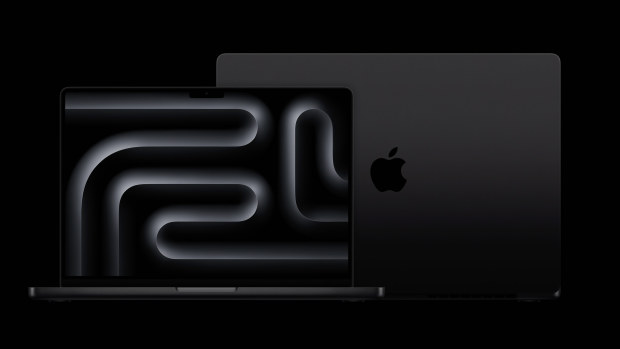Opinion

You want the new MacBook Pro. Here’s how to justify buying it
What if I told you I have stumbled upon a way to absolutely, positively need Apple’s ridiculously powerful M3 Max laptop?
John DavidsonColumnistThere is one, compelling reason not to buy Apple’s new MacBook Pro with the new M3 chip, however desperately you might want to.
You absolutely, positively don’t need such a powerful laptop. Not unless you’re some sort of video-making super geek who simply must edit 13 streams of 8K video on four external displays, or whatever stupid number of video streams this beast is capable of handling.

Apple’s new MacBook Pro M3 Max in the Space Black colour is both stealthy and flashy.
You don’t need to spend the money it takes to buy a laptop that powerful, and you don’t need to carry around the extra weight that comes with having a laptop that powerful.
For almost every mortal human under the sun, Apple’s 15-inch MacBook Air is the choice of champions. It’s much lighter (1.5 kg versus 2.1 kg for the 16-inch MacBook Pro we reviewed), and it’s much cheaper, starting at $2199 versus $4299 for the cheapest 16-inch MacBook Pro.
But what if I told you I have stumbled upon a way for mere mortals to absolutely, positively need not just the new MacBook Pro, but specifically the top-of-the-line M3 Max version of the MacBook Pro, thereby unlocking the stealthy-yet-flashy “Space Black” colour that Apple reserves for the top-end models?
AI.
No longer do you need to be a turtleneck-wearing “creative” to need a new MacBook Pro. Now you just need a good AI workload that helps you with some aspect of your work.
A month ago, the Digital Life Labs developed an app for this newspaper, that relies on a mid-strength large language model (LLM) to create some analytic data.
The details of the app aren’t important. What’s important is that a) even the fairly modest LLM we used is an utter pig of a computational workload that requires a beast of a machine just to get it to say “Hello”, and b) dreaming up your own use case for an LLM will take you no more than five minutes.

The keyboard and trackpad seem unchanged from previous models, but that’s how it should be. They’re great to work on.
We tried running our LLM on every laptop we have here in the Labs, including on a 15-inch MacBook Air M2 and on the powerful new Microsoft Surface Studio 2 laptop we’re also reviewing, as well as on an M2 Pro Mac Mini and an Intel NUC. It wouldn’t run on any of those machines.
We tried more modest LLMs, and they would run on some of the above computers, but they would spit out garbage results. When it comes to AI, bigger is much, much better.
The only way to make this app go was to run it on a Mac Studio M2 Ultra, one of the most powerful workstations Apple ever released. On such a machine, the app took 16 days running at 100 per cent GPU usage just to complete the preliminary stage of its task. Like I said, LLMs are pigs.
But here’s the exciting thing. This AI app also runs on the new MacBook Pro M3 Max, thanks to the larger amounts of graphics memory the M3 Max chip has access to. The most expensive models have 128 gigabytes of unified memory, opening up all sorts of machine-learning possibilities, though our review model has 96GB of memory and it still worked fine.
OK, our AI runs on the MacBook Pro at roughly half the speed of the Mac Studio Ultra (each datapoint takes 61.71 seconds on average to generate, versus 32.26 seconds on the Mac Studio) but at least it runs!
It’s also worth mentioning that Apple promises that even the most taxing workloads will run just as fast on the MacBook Pro, whether it’s connected to power or running on batteries.
That certainly seems to be the case. In our tests, the LLM workload kept going at the same speed, even when we disconnected the MacBook Pro from power.
Of course, the workload killed the battery (which went from 100 per cent charged, to 0 per cent charged, in just 81 minutes). But it never slowed down.
Speaking of battery life, it’s the one thing about the MacBook Pro we weren’t impressed by. Apple advertises you can get up to 22 hours of video streaming out of a single charge. Although we’re sure that’s true under the right circumstances, that’s significantly more than we ever got.
In moderate productivity usage running mostly web-based apps, we got about 12 hours of work done on a single charge. Streaming only YouTube videos, we got 18 hours.
Which of course is the battery life most of us can expect to get. Eighteen hours, not 81 minutes. AI is how you justify buying one of these machines, but that’s not actually what you’re going to do with it, is it?
Likes Loads of ports on the side. Great keyboard, trackpad and screen. Powerful.
Dislikes Hard to justify (until now!). Heavy. Battery life not what we hoped.
Price $8699 for the 16-inch model we reviewed, with the 14-core CPU and 96GB of unified memory. Faster versions with more storage and memory get as high as $11,699. In for a penny, in for a pound.
Introducing your Newsfeed
Follow the topics, people and companies that matter to you.
Find out moreRead More
Latest In Technology
Fetching latest articles